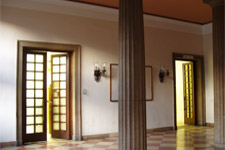How to: Presentation
Advice from members of the Admissions Committee for your presentation in Berlin
When you have passed the first hurdles of the selection and review process, you will be invited to Berlin.
- In Berlin, you will be expected to give a 10-minute academic presentation using slides (Power Point or similar), followed by a brief discussion.
- Your presentation will have to conform to the following format: You will have 10 minutes sharp for your presentation. We expect (1) a short summary of your academic background, (2) the results of your most recent academic work (e.g. your Master's thesis), and (3), and most importantly, the presentation of your proposed research project. The presentation will be followed by a discussion with the committee.
- Less is more. You have only 10 minutes to present. Choose your slides well or you will end up flashing through too high a number of slides with insufficient time to explain each one.
- Power Point (or Keynote or Prezi) is a visual tool. It is neither an electronic notepad nor a substitute for a text document or a spreadsheet. To make the most of it, use it wisely. Get inspiration here http://blog.visme.co/presentation-design/ and here http://www.presentationzen.blogs.com/presentationzen/2005/09/whats_good_powe.html
- Also, watch TED talks to learn from others. You can take cues from Chris Anderson, who is responsible for curating all TED talks, in this short video: https://www.youtube.com/watch?v=-FOCpMAww28
- Do not crowd your slides. If you feel you need too many elements on one slide, chances are your focus is not quite clear.
- Be careful with the use of colors. What might look nice on a small screen can easily look overwhelming or confusing when blown up on a large screen. Be especially careful with contrasting colors (e.g. blue and red, or green and red) as this can cause problems for people with color vision deficiency, or distract viewers and remove focus.
- Use only high-quality imagery, graphs and charts.
- Remember that your audience may be several feet away from the screen and may not be able to read or see very small details.
- Take your time. Don’t talk too fast. Remember that your audience hears your presentation for the first time and only once! The spoken language should be brief and concise. During the Q/A session, you will have the chance to elaborate.
- Like any language, what is considered “appropriate” body language will vary between cultures. For a presentation at the Berlin School of Mind and Brain, the audience here will be used to direct eye contact and a confident, but relaxed posture.
- Always face the audience, unless you are addressing a specific part of a slide. Do not be tempted to begin reading from the slides or notes.
- Practice, practice, practice. Time yourself until you can do the presentation in just under 10 minutes. This gives you the added confidence of a slight time puffer for unforeseen events.
- Get feedback. From a friend, colleague or from your family. If possible, have them film you so you can study your delivery and your body language. Ask yourself: Is my speech clear? My voice loud enough? Am I making eye contact? More tips on delivery here: http://www.garrreynolds.com/preso-tips/deliver/
- Practice some more. It cannot be stressed enough. If you ever saw a great presentation, you can be sure that 90% of the performance was due to sufficient preparation and practice.
- Try to calm your nerves. Remember: You received an invitation because we are impressed with your academic achievements. Now we want to get to know you and your research better.
- Dress code: There is no real dress code for presentations before our committee. Dress codes at German universities vary according to the field of study, e.g., law and economics students dress more formally for study and presentations than students in the neurosciences and philosophy. However: sleeveless tops are never recommended. And beach wear such as shorts and flip-flops will not be appropriate for on-site interviews. If you are unsure: Business casual is always fine.



